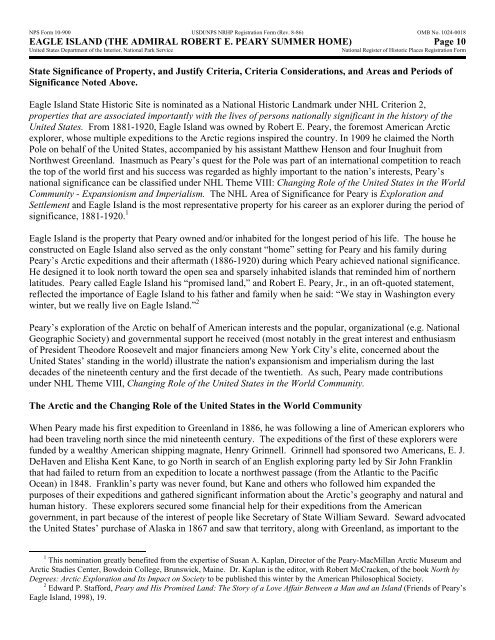Nomination - National Park Service
Nomination - National Park Service
Nomination - National Park Service
Create successful ePaper yourself
Turn your PDF publications into a flip-book with our unique Google optimized e-Paper software.
NPS Form 10-900 USDI/NPS NRHP Registration Form (Rev. 8-86) OMB No. 1024-0018<br />
EAGLE ISLAND (THE ADMIRAL ROBERT E. PEARY SUMMER HOME) Page 10<br />
United States Department of the Interior, <strong>National</strong> <strong>Park</strong> <strong>Service</strong><br />
<strong>National</strong> Register of Historic Places Registration Form<br />
State Significance of Property, and Justify Criteria, Criteria Considerations, and Areas and Periods of<br />
Significance Noted Above.<br />
Eagle Island State Historic Site is nominated as a <strong>National</strong> Historic Landmark under NHL Criterion 2,<br />
properties that are associated importantly with the lives of persons nationally significant in the history of the<br />
United States. From 1881-1920, Eagle Island was owned by Robert E. Peary, the foremost American Arctic<br />
explorer, whose multiple expeditions to the Arctic regions inspired the country. In 1909 he claimed the North<br />
Pole on behalf of the United States, accompanied by his assistant Matthew Henson and four Inughuit from<br />
Northwest Greenland. Inasmuch as Peary’s quest for the Pole was part of an international competition to reach<br />
the top of the world first and his success was regarded as highly important to the nation’s interests, Peary’s<br />
national significance can be classified under NHL Theme VIII: Changing Role of the United States in the World<br />
Community - Expansionism and Imperialism. The NHL Area of Significance for Peary is Exploration and<br />
Settlement and Eagle Island is the most representative property for his career as an explorer during the period of<br />
significance, 1881-1920. 1<br />
Eagle Island is the property that Peary owned and/or inhabited for the longest period of his life. The house he<br />
constructed on Eagle Island also served as the only constant “home” setting for Peary and his family during<br />
Peary’s Arctic expeditions and their aftermath (1886-1920) during which Peary achieved national significance.<br />
He designed it to look north toward the open sea and sparsely inhabited islands that reminded him of northern<br />
latitudes. Peary called Eagle Island his “promised land,” and Robert E. Peary, Jr., in an oft-quoted statement,<br />
reflected the importance of Eagle Island to his father and family when he said: “We stay in Washington every<br />
winter, but we really live on Eagle Island.” 2<br />
Peary’s exploration of the Arctic on behalf of American interests and the popular, organizational (e.g. <strong>National</strong><br />
Geographic Society) and governmental support he received (most notably in the great interest and enthusiasm<br />
of President Theodore Roosevelt and major financiers among New York City’s elite, concerned about the<br />
United States’ standing in the world) illustrate the nation's expansionism and imperialism during the last<br />
decades of the nineteenth century and the first decade of the twentieth. As such, Peary made contributions<br />
under NHL Theme VIII, Changing Role of the United States in the World Community.<br />
The Arctic and the Changing Role of the United States in the World Community<br />
When Peary made his first expedition to Greenland in 1886, he was following a line of American explorers who<br />
had been traveling north since the mid nineteenth century. The expeditions of the first of these explorers were<br />
funded by a wealthy American shipping magnate, Henry Grinnell. Grinnell had sponsored two Americans, E. J.<br />
DeHaven and Elisha Kent Kane, to go North in search of an English exploring party led by Sir John Franklin<br />
that had failed to return from an expedition to locate a northwest passage (from the Atlantic to the Pacific<br />
Ocean) in 1848. Franklin’s party was never found, but Kane and others who followed him expanded the<br />
purposes of their expeditions and gathered significant information about the Arctic’s geography and natural and<br />
human history. These explorers secured some financial help for their expeditions from the American<br />
government, in part because of the interest of people like Secretary of State William Seward. Seward advocated<br />
the United States’ purchase of Alaska in 1867 and saw that territory, along with Greenland, as important to the<br />
1 This nomination greatly benefited from the expertise of Susan A. Kaplan, Director of the Peary-MacMillan Arctic Museum and<br />
Arctic Studies Center, Bowdoin College, Brunswick, Maine. Dr. Kaplan is the editor, with Robert McCracken, of the book North by<br />
Degrees: Arctic Exploration and Its Impact on Society to be published this winter by the American Philosophical Society.<br />
2 Edward P. Stafford, Peary and His Promised Land: The Story of a Love Affair Between a Man and an Island (Friends of Peary’s<br />
Eagle Island, 1998), 19.
















